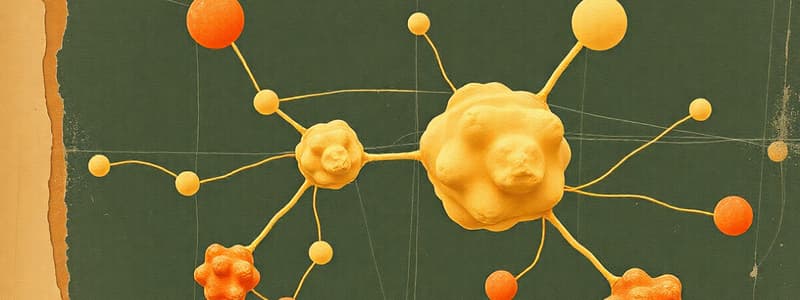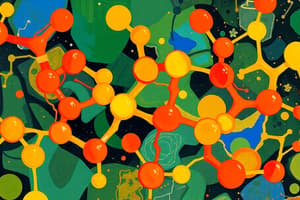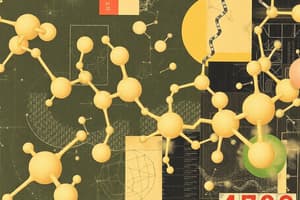Podcast
Questions and Answers
What type of carbohydrate consists of 3 to 10 monosaccharides covalently linked?
What type of carbohydrate consists of 3 to 10 monosaccharides covalently linked?
- Disaccharides
- Polysaccharides
- Monosaccharides
- Oligosaccharides (correct)
Which term describes sugars that can undergo mutarotation?
Which term describes sugars that can undergo mutarotation?
- Cyclic hemiacetals
- Reducing sugars (correct)
- Polysaccharides
- Nonreducing sugars
Which of the following correctly describes polysaccharides?
Which of the following correctly describes polysaccharides?
- Simple sugars with multiple OH groups
- Polymers consisting of chains of monosaccharide or disaccharide units (correct)
- Two monosaccharides covalently linked
- Compounds with only one type of monosaccharide
What distinguishes diastereomers from other isomers?
What distinguishes diastereomers from other isomers?
What is a characteristic feature of monosaccharides?
What is a characteristic feature of monosaccharides?
What term is used to describe a monosaccharide with five carbon atoms?
What term is used to describe a monosaccharide with five carbon atoms?
Which type of monosaccharide contains a ketone functional group?
Which type of monosaccharide contains a ketone functional group?
What characteristic of the carbonyl group in glucose allows for chirality in its hydroxy groups?
What characteristic of the carbonyl group in glucose allows for chirality in its hydroxy groups?
Which of the following statements about D- and L-sugars is true?
Which of the following statements about D- and L-sugars is true?
Which term describes a monosaccharide with six carbon atoms and an aldehyde functional group?
Which term describes a monosaccharide with six carbon atoms and an aldehyde functional group?
In fructose, how many of the hydroxy groups are chiral?
In fructose, how many of the hydroxy groups are chiral?
What is the primary characteristic that makes the carbonyl carbon in glucose achiral?
What is the primary characteristic that makes the carbonyl carbon in glucose achiral?
Which structural feature of D-glyceraldehyde is significant for determining D- and L- configurations in sugars?
Which structural feature of D-glyceraldehyde is significant for determining D- and L- configurations in sugars?
What type of polysaccharide contains only α-glucose units?
What type of polysaccharide contains only α-glucose units?
Which reagent is used to oxidize aldehydes in a basic solution?
Which reagent is used to oxidize aldehydes in a basic solution?
In the structure of amylopectin, what type of glycosidic bond connects glucose units at branched points?
In the structure of amylopectin, what type of glycosidic bond connects glucose units at branched points?
What effect describes the preference for certain substituents to occupy the axial position on the anomeric carbon?
What effect describes the preference for certain substituents to occupy the axial position on the anomeric carbon?
What structural component distinguishes storage polysaccharides from structural polysaccharides?
What structural component distinguishes storage polysaccharides from structural polysaccharides?
How many glucose units typically make up a chain of amylose?
How many glucose units typically make up a chain of amylose?
What molecule forms when glucose is caramelized by heating?
What molecule forms when glucose is caramelized by heating?
What is the primary storage location for glycogen in the body?
What is the primary storage location for glycogen in the body?
What determines whether a hexose is classified as a D-sugar or an L-sugar?
What determines whether a hexose is classified as a D-sugar or an L-sugar?
What characteristic distinguishes epimers from enantiomers?
What characteristic distinguishes epimers from enantiomers?
What happens when an aldehyde is attacked by an alcohol?
What happens when an aldehyde is attacked by an alcohol?
Which form of aldohexoses is considered most stable and prevalent in nature?
Which form of aldohexoses is considered most stable and prevalent in nature?
How can aldoses and ketoses be distinguished in a laboratory setting?
How can aldoses and ketoses be distinguished in a laboratory setting?
What is the result of the nucleophilic attack of an alcohol on the electrophilic carbonyl carbon in sugars?
What is the result of the nucleophilic attack of an alcohol on the electrophilic carbonyl carbon in sugars?
Which reagent can oxidize both aldoses and ketoses to their respective aldonic acids?
Which reagent can oxidize both aldoses and ketoses to their respective aldonic acids?
What is true about the configurations of chiral centers when determining an L-aldose?
What is true about the configurations of chiral centers when determining an L-aldose?
Flashcards
Monosaccharides
Monosaccharides
Simple sugars with multiple hydroxyl (-OH) groups. They are the basic building blocks of carbohydrates.
Disaccharides
Disaccharides
Two monosaccharides linked together by a glycosidic bond.
Polysaccharides
Polysaccharides
Long chains of monosaccharides or disaccharides linked together.
Oligosaccharides
Oligosaccharides
Signup and view all the flashcards
Glycosidic bond
Glycosidic bond
Signup and view all the flashcards
Triose, Tetrose, Pentose, Hexose
Triose, Tetrose, Pentose, Hexose
Signup and view all the flashcards
Aldose
Aldose
Signup and view all the flashcards
Ketose
Ketose
Signup and view all the flashcards
Aldohexose
Aldohexose
Signup and view all the flashcards
Ketohexose
Ketohexose
Signup and view all the flashcards
Aldopentose
Aldopentose
Signup and view all the flashcards
Ketopentose
Ketopentose
Signup and view all the flashcards
Chiral Center
Chiral Center
Signup and view all the flashcards
D-sugar
D-sugar
Signup and view all the flashcards
L-sugar
L-sugar
Signup and view all the flashcards
Epimers
Epimers
Signup and view all the flashcards
Enantiomers
Enantiomers
Signup and view all the flashcards
Hemiacetal
Hemiacetal
Signup and view all the flashcards
Hemiketal
Hemiketal
Signup and view all the flashcards
Pyranose
Pyranose
Signup and view all the flashcards
Furanose
Furanose
Signup and view all the flashcards
Tollens' Reagent
Tollens' Reagent
Signup and view all the flashcards
Structural Polysaccharides
Structural Polysaccharides
Signup and view all the flashcards
Study Notes
Biomolecules - Carbohydrates
- Carbohydrates are biomolecules closely associated with living organisms
- They are components of coenzymes, antibiotics, bacterial cell walls, and mammalian cell membranes
- They provide energy through oxidation (in plants, animals, and humans)
- They supply carbon for building cell components
- They serve as stored chemical energy
- They are structural components of nucleic acids (ribose in RNA and deoxyribose in DNA)
- Various forms of cellulose make up materials like cotton and linen, and are also the basic component of wood
Carbohydrate Structure and Classification
- Carbohydrates are typically polyhydroxyaldehydes, polyhydroxyketones, or substances that yield these compounds through hydrolysis
- Classified as monosaccharides, disaccharides, oligosaccharides, or polysaccharides based on their structure
Monosaccharides
- Basic nomenclature: The number of carbon atoms in a carbohydrate plus the suffix "-ose". (e.g., three carbons = triose).
- Functional groups: All carbohydrates initially contain a carbonyl functional group. Aldose is a carbohydrate with aldehyde functionality; ketose is a carbohydrate with ketone functionality.
- Isomers: Monosaccharides can have different arrangements of their atoms, resulting in structural isomers like aldoses and ketoses.
- Chirality: Monosaccharides often have chiral carbon centers, leading to stereoisomers. D- and L- designations are determined based on the configuration of the chiral carbon farthest from the aldehyde or ketone group.
- Epimers: These diastereomers differ only in the configuration at one stereogenic center.
- Examples: Glucose, fructose, glyceraldehyde, ribose.
Cyclic Structures of Monosaccharides
- Hemiacetal and Hemiketal formation: Aldehydes or ketones react with an alcohol to create cyclic hemiacetals or hemiketals.
- Pyranoses and Furanoses: Cyclized monosaccharides can form six-membered rings (pyranoses) or five-membered rings (furanoses) according to ring strain and other factors. The orientation of the hydroxyl group at the anomeric carbon can be α or β.
- Haworth projections: These representations show the cyclic structure of a sugar in a flat, two-dimensional form, with substituents oriented above or below the ring.
Anomeric Carbons and Mutarotation
- Anomeric carbon: The carbon atom in the ring structure that was previously the carbonyl carbon (C=O) of the open-chain form. It is a new asymmetric center, because the group was not asymmetrical before cyclization.
- Anomers: α and β forms of the same sugar that differ in the configuration around the anomeric carbon.
- Mutarotation: The phenomenon where anomers interconvert in solution, shifting the equilibrium between the α and β forms.
Reactions of Monosaccharides
- Epimerization: Base-catalyzed reaction where a hydroxyl group at the carbon changes its configuration.
- Enediol formation: A reaction involving the formation of intermediates through keto-enol tautomerism, changing the configuration of the carbonyls.
- Reduction: Reduction of the carbonyl group of an aldose or ketose creates an alditol, an acyclic alcohol.
- Oxidation: Oxidation of an aldehyde group to produce an aldonic acid using mild or strong oxidizing agents, or using enzymes.
- Acylation: Adding acyl groups (organic groups containing a carbonyl) to form esters.
- Alkylation: Replacing hydroxyl groups with alkyl groups to form ethers
- Formation of glycosides: Replacing the anomeric alcohol on a carbohydrate with another alcohol, creating a glycoside.
Reducing and Nonreducing Sugars
- Reducing sugars: Monosaccharides or disaccharides that can reduce oxidizing agents by producing a hemiacetal group.
- Nonreducing sugars: Lack a free hemiacetal group present in an open-chain conformation and cannot reduce oxidizing agents.
Disaccharides
- Disaccharide Formation: The bond between two monosaccharides via a glycosidic linkage between one unit's anomeric carbon and the other unit's hydroxyl group.
- Examples: Maltose, Cellobiose, Lactose, Sucrose
Polysaccharides
- Polysaccharide Structure: Polymers of monosaccharides linked via glycosidic bonds.
- Types:
- Storage: Amylose, Amylopectin, Glycogen
- Structural: Cellulose, Chitin
Specific Examples
- Glycogen: A storage polysaccharide found in animals, structurally similar to amylopectin, with more frequent branching.
- Cellulose: A structural polysaccharide found in plants having linear chains of glucose connected via β-1,4 linkages. These chains align parallel to form rigid structures. Humans cannot break down cellulose.
- Starch: A storage polysaccharide in plants consisting of amylose and amylopectin. These provide energy storage.
- Gentiobiose: A disaccharide made from the linkage of two glucose monomers via β-glycosidic linkage.
Studying That Suits You
Use AI to generate personalized quizzes and flashcards to suit your learning preferences.




